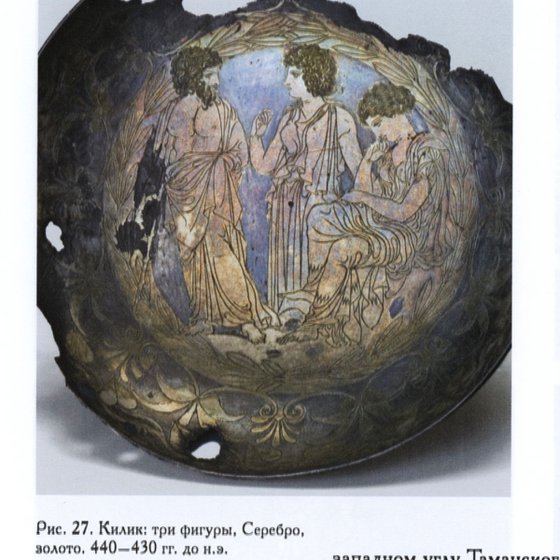Main Navigation
Original artwork description:
Steps to the future, 80x120 cm, oil on canvas
The painting uses a drawing depicted on a bowl (Kilik: three figures, silver, gold, 440-430 BC) in the form of a shadow on a cliff from the past. The finds of archaeologists on the site of ceramics and other objects from the past are steps into the future.
This is how the section of the settlement looks like. All these layers from the 6th century BC to the present day, one after another, were formed from construction and household debris and buried the remains of buildings.
Clay buildings were destroyed quickly, new ones were erected in their place. Therefore, for 26 centuries, the cultural layer here has reached 12 meters.
The Hermonassa settlement is located in the center of modern Taman. The earliest buildings excavated here are dated to the middle of the VI century BC. This land preserves traces of Greek colonization, Roman domination, the Great Migration of Peoples, the history of the Khazar Khaganate, the campaigns of the princes of Kievan Rus, the Genoese colony, Ottoman rule, the events of the annexation of Taman to Russia, the Crimean, Civil and Great Patriotic Wars.
The city has changed its name many times. The ancient Greeks called it Hermonassa, the Khazars - Matluka or Tamatarch, the Slavs - Tmutarakan, the Polovtsians - Matrika or Matarcha, the Genoese - Matrega, the Turks - Taman.
Materials used:
oil on canvas
Tags:
#seascape #blue #orange #plein air #sunset abstract #sea impression #sea oil #lsndscape paintings #sea abstracts #summer abstactionSteps to the future (2023) Oil painting
by Olga Bezhina
£2,570.04
- Oil painting on Canvas
- One of a kind artwork
- Size: 120 x 80 x 2cm (unframed)
- Ready to hang
- Signed on the front
- Style: Expressive and gestural
- Subject: Landscapes, sea and sky
Loading
Original artwork description
Steps to the future, 80x120 cm, oil on canvas
The painting uses a drawing depicted on a bowl (Kilik: three figures, silver, gold, 440-430 BC) in the form of a shadow on a cliff from the past. The finds of archaeologists on the site of ceramics and other objects from the past are steps into the future.
This is how the section of the settlement looks like. All these layers from the 6th century BC to the present day, one after another, were formed from construction and household debris and buried the remains of buildings.
Clay buildings were destroyed quickly, new ones were erected in their place. Therefore, for 26 centuries, the cultural layer here has reached 12 meters.
The Hermonassa settlement is located in the center of modern Taman. The earliest buildings excavated here are dated to the middle of the VI century BC. This land preserves traces of Greek colonization, Roman domination, the Great Migration of Peoples, the history of the Khazar Khaganate, the campaigns of the princes of Kievan Rus, the Genoese colony, Ottoman rule, the events of the annexation of Taman to Russia, the Crimean, Civil and Great Patriotic Wars.
The city has changed its name many times. The ancient Greeks called it Hermonassa, the Khazars - Matluka or Tamatarch, the Slavs - Tmutarakan, the Polovtsians - Matrika or Matarcha, the Genoese - Matrega, the Turks - Taman.
Materials used:
oil on canvas
Tags:
#seascape #blue #orange #plein air #sunset abstract #sea impression #sea oil #lsndscape paintings #sea abstracts #summer abstaction14 day money back guaranteeLearn more
















